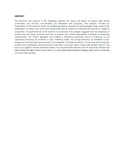| dc.contributor.author | Schmidt, G | |
| dc.date.accessioned | 2014-04-28T11:42:42Z | |
| dc.date.available | 2014-04-28T11:42:42Z | |
| dc.date.issued | 1979 | |
| dc.identifier.citation | Occasional Paper, Institute for Development Studies, University College, Nairobi 1979 pp. 155pp. | en_US |
| dc.identifier.uri | http://www.cabdirect.org/abstracts/19801867819.html?resultNumber=10&start=10&q=do%3A%22Occasional+Paper%2C+Institute+for+Development+Studies%22 | |
| dc.identifier.uri | http://hdl.handle.net/11295/66089 | |
| dc.description.abstract | The structure and conduct of the marketing systems (for maize and beans in Kenya), both formal (controlled) and informal (uncontrolled) are described and analyzed. The analysis includes an examination of the extent to which the marketing systems operate at lowest possible costs, prevent the exploitation of farmers and consumers and provide secure outlets for producers and sources of supply to consumers. The performance of the controls is scrutinized. The analysis suggests that the objectives of controls are not being achieved and that at present the controls themselves contribute to marketing inefficiencies. The control legislation has created a marketing framework which is conducive to low operational efficiency as reflected in high marketing costs, low pricing efficiency as reflected in poor integration and fairly high excess profits; and instability of market conditions. Those most affected by the controls are smallholders and low-income consumers (rural and urban), large-scale farmers benefit. The result is a negative income distribution effect. It is recommended that the controls should be relaxed and other measures taken which would also fit in with present development strategy which aims to alleviate rural and urban poverty. | en_US |
| dc.language.iso | en | en_US |
| dc.publisher | University of Nairobi, | en_US |
| dc.title | Maize and beans in Kenya: the interaction and effectiveness of the informal and formal marketing systems. | en_US |
| dc.type | Technical Report | en_US |

